
Products&Technology
Category
DH series dry type roller press compactor
Category: Products
Flakes exiting the roller press are typically too large tobe conveyed. This is why a flake breaker is often installed directly beneath the roller press. A special chute can be added that allows flake samples to be taken. It is mainly composed of crusher housing and chamber, rotary crushing cutter wheel, motor, reducer, bearing seat, main shaft and upper and lower material inlet and outlet.The crusher housing is composed of the main shaft and the rotary crushing cutter wheel, and the main shaft is driven by the motor. DH series dry type roller press compactor is one of the main products of Jiangsu Fuyu Intelligent Equipment Co.Ltd. with products with good price and quality.Our factory is a professional suppliers china and Manufacturers china,Discount available for customized wholesale.
Material Granulated by compaction
| ● Ammoniumchloride | ● Potassiumrock | ● Sodium chloride | ● Dry municipal sludge |
| ● Ammoniumsulfate | ● Potassiumchloride | ● Sodium nitrate | ● De-icing salt |
| ● Burnt lime | ● Potassiumsulfate | ● Sulfate of potash magnesia | ● Industrial potash |
| ● Calcium nitrate | ● Sodium carbonate(soda) | ● Bentonite | ● Micro-nutrients |
| ● Sodium formate |
Compaction is the process of compressing fine-grained solids between counter-rotating smooth or profiled rollers. The resulting band of material, known as flake, is an intermediate product from which the final granulate is produced using crushing and screening processes. While the technology is also found in many chemcial industry applications, the compaction process traditionallyismainlyusedtoproduceeithersingle-component(KCL,SOP.AS) or multi-component(NPK fertilizers.
Typical Fertilizer Granulate size

Technology Focused On Fertilizer Production
Besides signle-component fertilizer which for example contain only K(potassium), mixed fertilizer are also available. These each contain either two or allof the nutrients N(nitrogen),P(phosphor) and K. The use of granulated fertilizers largely avoids segregation, uncontrolled agglomeration and unsatisfactory flow characteristics, or losses during application due to dusting or run-off. In contrast to the wet granulation process, compaction-granulation requires neither drying nor the addition of binders. Fuyi not only manufactures rollers presses but also provides complete fertilizer production plants. Additionally, our range of services includes compaction tests, processlayout, basic engineering plus installation and start-up support.
DH series dry type roller press compactor is one of the main products of Jiangsu Fuyu Intelligent Equipment Co.Ltd. with products with good price and quality.Our factory is a professional suppliers china and Manufacturers china,Discount available for customized wholesale.
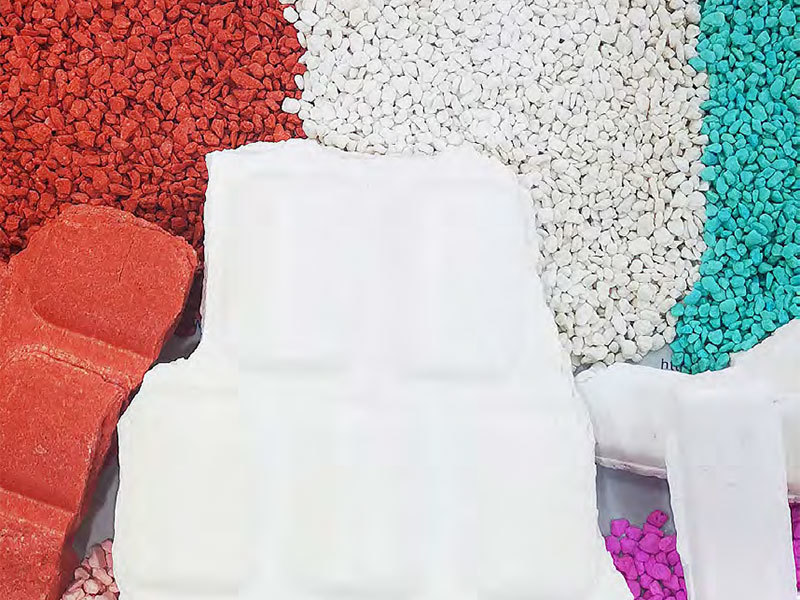
Design Feature
Modular Design for Customized Flexibility
Compaction with roller presses follows a simple princple: a fine raw material is fed into the space between two counter-roating rollers, where it is then compressec and formed into flakes. The main functional assemblies provided for this purpose are:
● Press frame
● Pressing rollers with bearings and bearing housings
● Main drive with reduction gear
● Material feeder: Quantitative screw feeding and forced screw feeding
● Hydraulic pressuring system
● Grease lubrication
● Roller housing
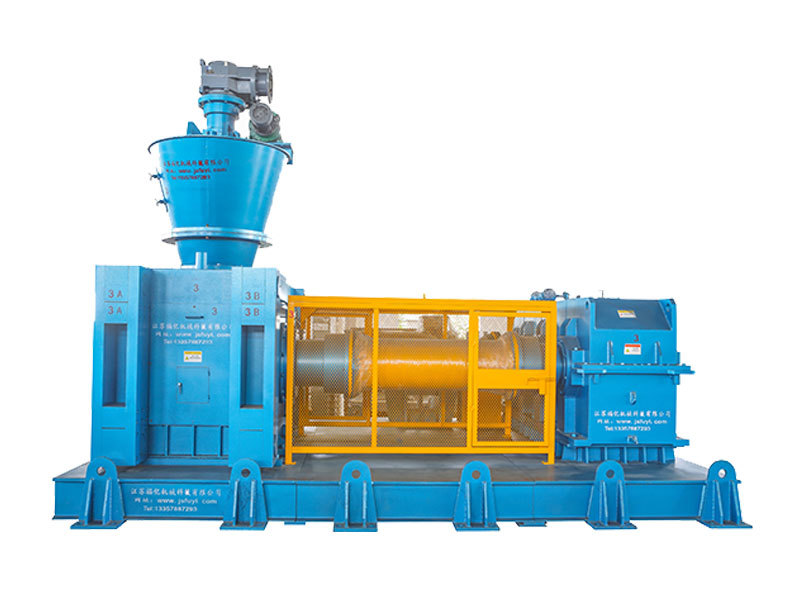
The fixed roller is supported directly in the press frame, while the so-called floating roller is also supported in the frame. The movement of the floating roller constitutesthe basic principle of a roller press. The rollers are driven either by one electric motor in combination with adouble-shaft gear box and tooth couplings.
The extent of the roller movement defines the roller ga. It is a function of the pressing force generated by the hydraulic system in relation to the reaction forces exerted by the material being processed and the preset 'zero-position' of the roller gap. Depending on the requirementsof the specific process, the gap itself is controlled by means of feed screw speeds.
These design features guarantee that all the feed material passes through the rower gap under the same process conditions, thus ensuring that the autput quality of the product remains constant.
Normally,the roller materials adopts alloy steel.Theyy are sufficiently wear-resistant to ensure maximum service life and minimum expense, whereby conventlonal pressing tools can be refurbished and re-used. Roller surface patterns are generated by electrochemical machining(ECM). High-alloy materials such as chromiumilybdenumalkys, powder metallurgy materials or hardened metals can be easily machined.
This machining process leaves no burrs, ensures excellentsurface quality and does not subject the work piece to thermal stress, as machining temperatures are below 90℃. A roller housing is provided for safely reasons and to minimize dust errission.
Factors determining the selection of machine type are∶
● Requiredapplication
● Attainable peripheral speed
● Specific pressing force requirements
● Product shape and size
● Design of pressing tools and material feeders
Flake Breaker
Flakes exiting the roller press are typically too large tobe conveyed. This is why a flake breaker is often installed directly beneath the roller press. A special chute can be added that allows flake samples to be taken. It is mainly composed of crusher housing and chamber, rotary crushing cutter wheel, motor, reducer, bearing seat, main shaft and upper and lower material inlet and outlet.The crusher housing is composed of the main shaft and the rotary crushing cutter wheel, and the main shaft is driven by the motor.
Equipment parameters
| Model /Project | DH360 | DH450 | DH650 | DH850 | DH1050 |
| Roller diameter (mm) | Φ360 | Φ450 | Φ650 | Φ850 | Φ1050 |
| Valid usable width of roller (mm) | 170-230 | 190-280 | 290-330 | 420-450 | 450-500 |
| Rotation rate (rpm) | It can be adjusted on site according to different material characteristics | ||||
| Maximum thickness of lakes (mm) | 8 | 12 | 16 | 32 | 45 |
| Flakes output (t/h) | 1.3-2.3 | 2.5-3.5 | 5.0-7.0 | 12-22 | 22-45 |
| Finished product output (t/h) | 0.9-1.3 | 1.8-2.5 | 3.5-4 | 5-8 | 10-16 |
| Compactor power (KW) | 30-37 | 55-75 | 110-132 | 220-250 | 400-550 |
| Total power for whole line (KW) | 55 | 90 | 175 | 400 | 850 |
| External dimension (mm) | 2350×2000×2600 | 2600×2200×2900 | 3600×2800×3200 | 5000×3800×4100 | 7000×5000×6000 |
| Compactor weight (t) | 7 | 10 | 21 | 46 | 93 |
Process Technology
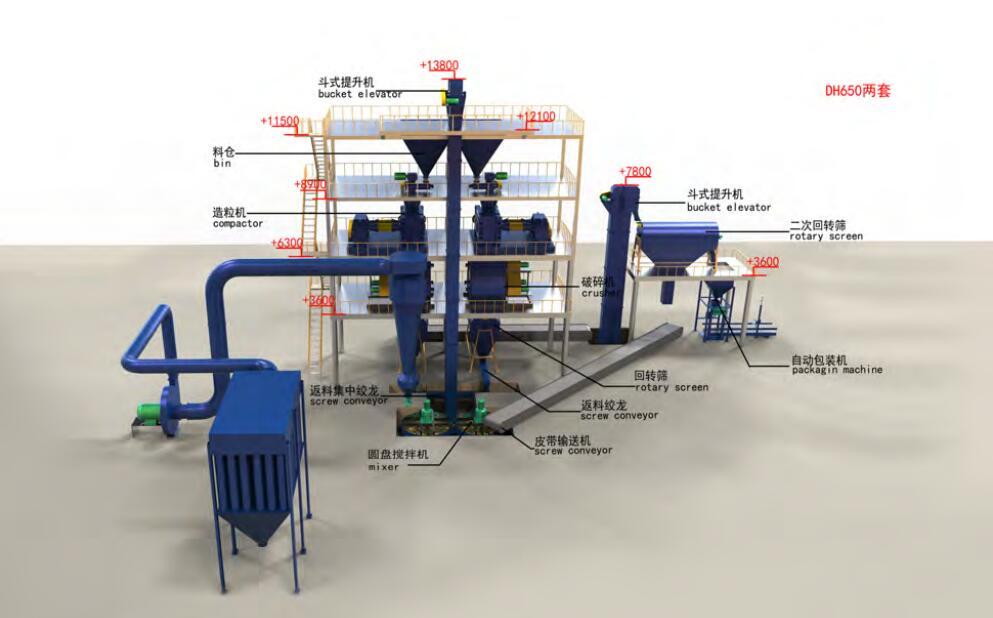
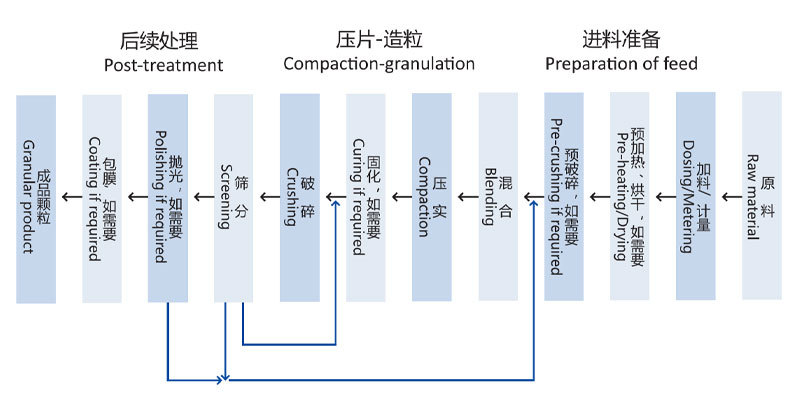
Comprehensive and Customized
The gereral flow sheet of a fertilizer compaction-glranulation plant comprises three process groups of machinery corresponding to the following process steps:
● Feed material preparation
● Compaction-granulation
● Post-treatment
The material is transported within the plant by various means such as bucket elevator or belt and scraper conveyors.
Feed Materation Preparetion
Typically, the feed materials are dosed and processsed continuously, whereby the number of bins used depneds on the number of feed material components tobe incorporated in the final proudct. Some feed materials require crushing, either to reduce feed size or to break uo coated surfaces. Drying or pre-heating may need to be foreseen depending on the feed material. In some multiple fertilizer plants(NPK fertilizers), batch dosing and mixing has also been applied. Components are metered into a weigh bin. The completed formulation is then discharged into a batch mixer. A surge bin connects the discontinuous feed preparation with the continuously operationg compaction process. Whichever operation is used, the selection as well as the arrangement of mixer, crusher and dosing equipment requires careful consideration.
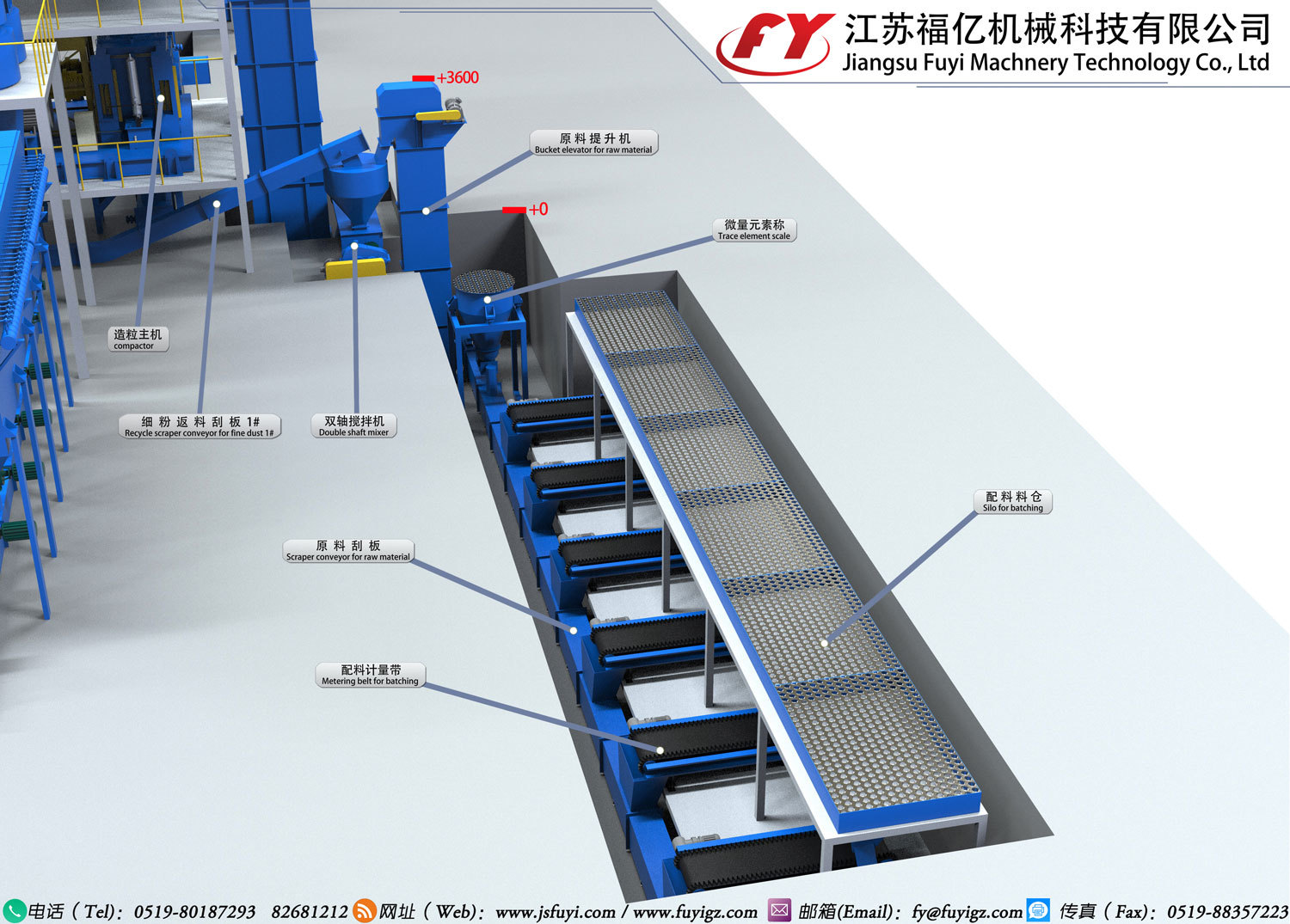
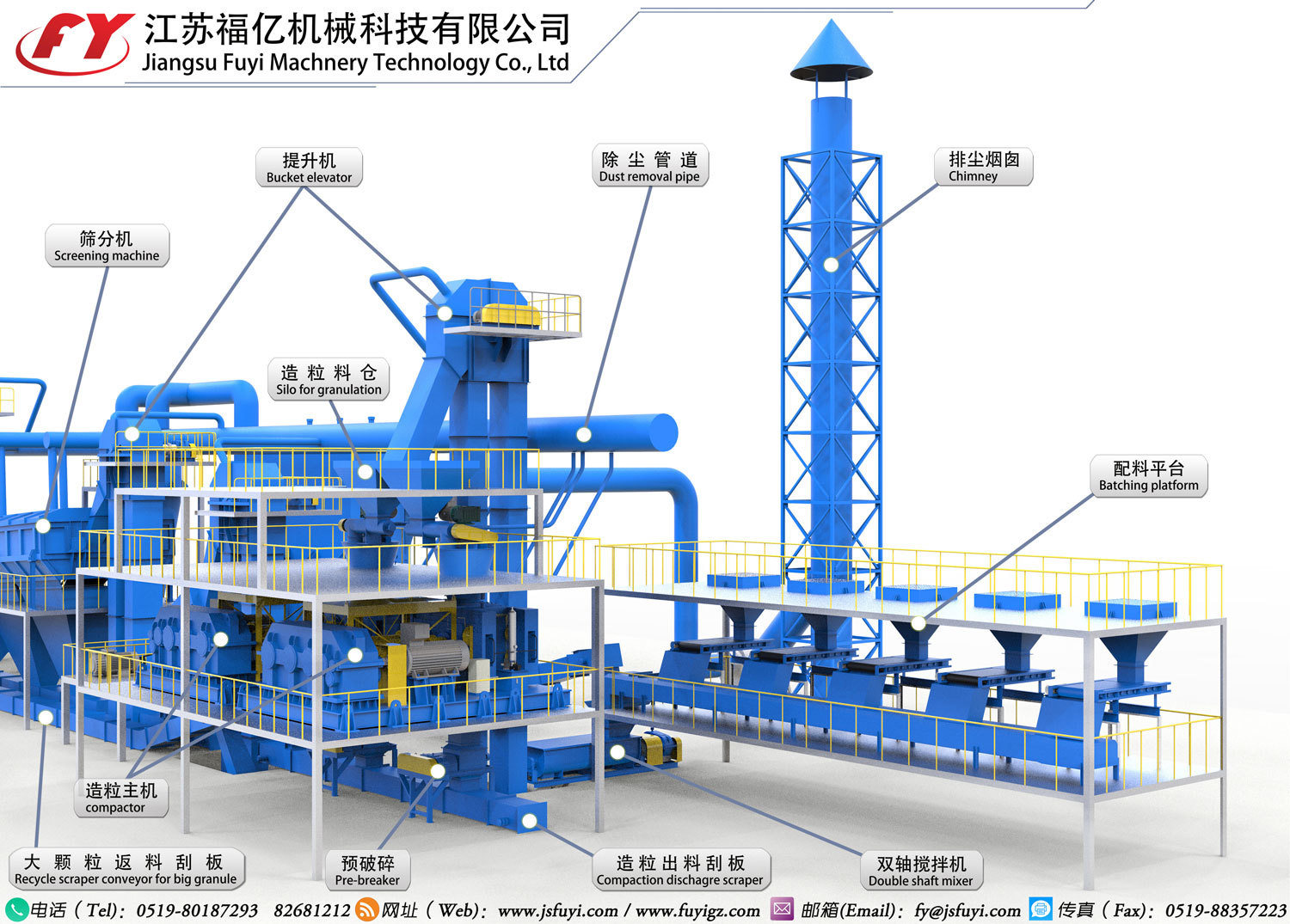
Compaction-Granulation
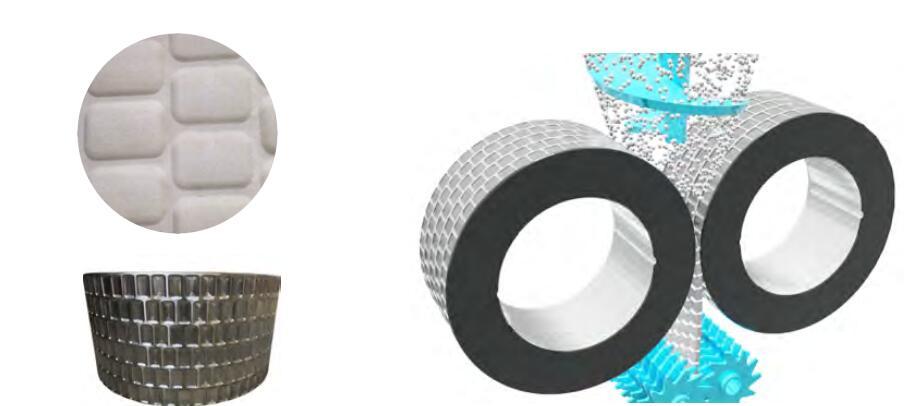
Using FUYI roller presses based on the principle of press-agglomeration, material is introduced into the gap of the two counter-rotating rollers by vertical forced feedscrews. As the material is compacted, pressure within the material increases, reaching a peak just above the line of closest approach between the rollers, and subsequently dropping rapidly to zero. During this process, the apparent density of the mixtureincreases by a factor of 1.5-2 due to the decreasing void volume of the bulk material. The resulting product is typically a flake of 5-45mm thickness. The flake produced in the roller press must be broken up and classified into the desired particle size range. Often, the first crushing step takes place in a speciallydesigned flake breaker installed directly below the roller press. The flake is broken into smaller pieces which make suitable feed for subsequent crushers. Using a multi-deck screen, the material is then separated into oversize, product and undersize frractions. The undersize(which passes directly through to the lowesst screen deck) is re-circulated for compaction, while the oversize forms a residue on the upper screen deck which is fed into the crushing process. Many mixed fertilizers, particulary those containing phosphates and/or urea, initially priduce relatively soft, plastic flakes that harden during aging. For this,a curing bin is installed ahead of the crusher. The economics of a fertilizer compaction-granulation ssystem depend strongly on the appropriate roller press design and the correct selection of crushing and sizing equipment. In addition to particle shape and size ranges, the compaction process as well as the crushing and screening circuits determine the yield and output of a plant.
Design With Curing Bin
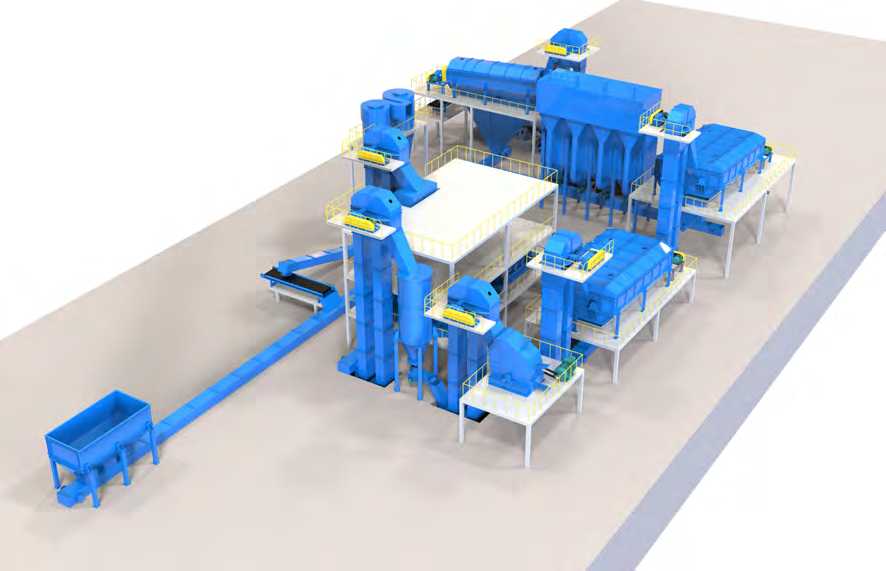
Design Without Curing Bin
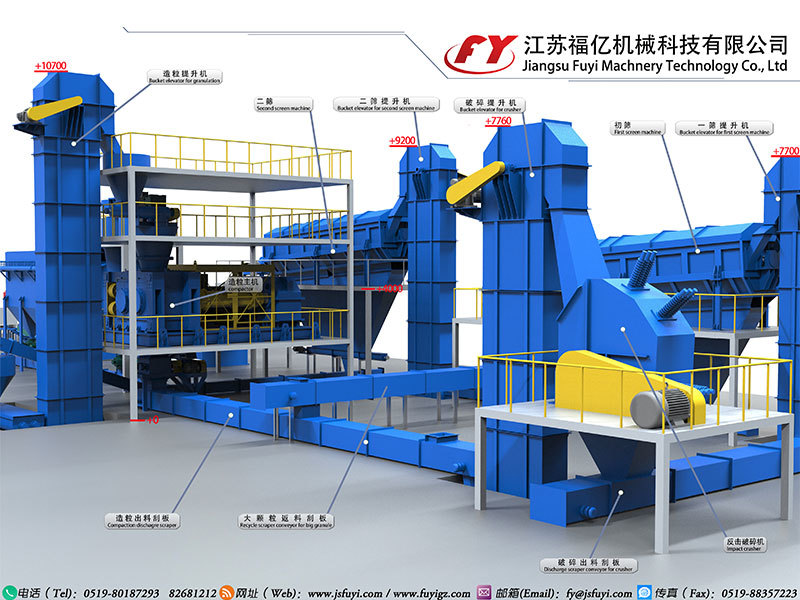
Post-Treatment
Fertilizer granules are exposed to multiple stresses in the logistics chain during transportaion, storge and packaging. Such stresses can be caused by:
● Static strain due to the high load during storage
● Friction between the granules under high load while being removed from storage
● Friction between the granules while being conveyed in bulk streams(conveyor transfer point, chutes)
● Impact on each other, or on metal or concrete surfaces
● Avsorption and emission of water during storage and /or transport.
Two possible post-treatroent methods can be used to reduce the effect of these stresses;
Standard post-treatment
Standard post-treatment is defined by the process steps of:
● polishing
● coating
First of all, the irregular-shape particles are polished iin an abrasion drum in order to round off sharp edges and corners. The fines produced are removed by single-deck screening and subsequently re-circulated to the compaction circuit. They are then coated with an anti-caking agent, which helps to prevent not only the caking of individual particles but also dust generationcaused by abrasion.

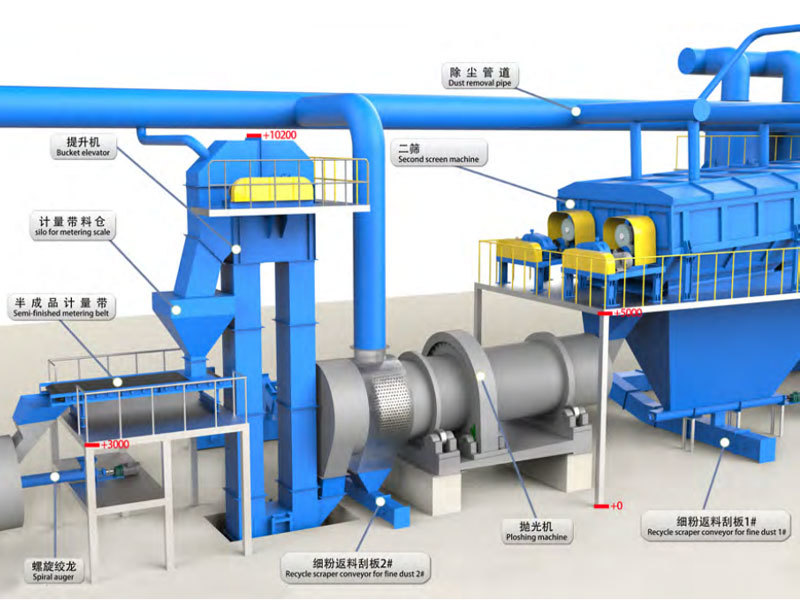
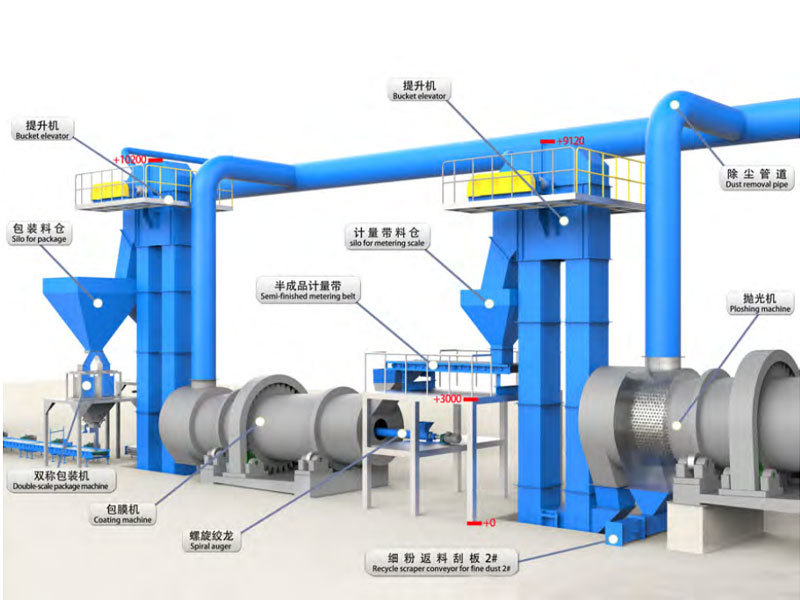
Fields of Application
Compaction-Granulation Plant
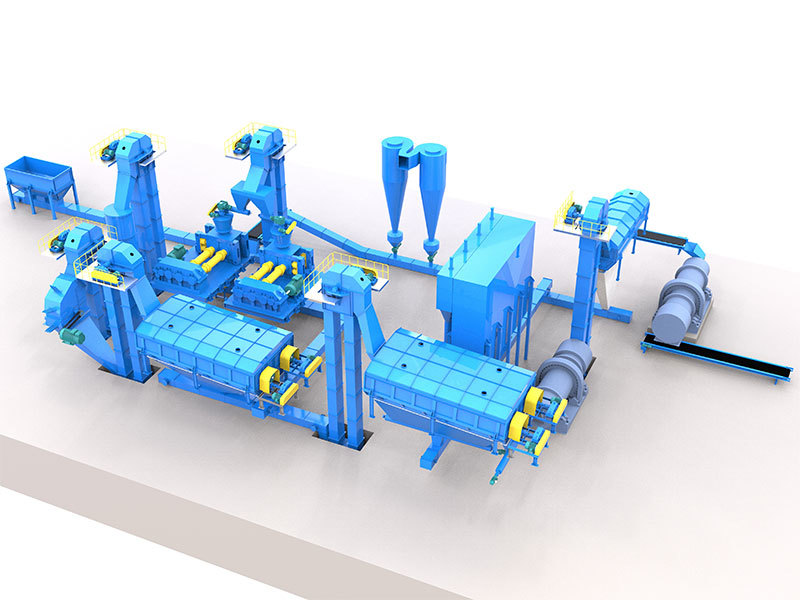
Single-Nutrient Fertilizers
The illustration shows a compaction-granulation plant for MOP with 60%K2O content. Compaction of such fertilizers typically takes place at elevated feed temperaatures, the crushers working in a closed-loop cycle with multi-deck screens to crush the flakes into granules. In some cases, raw materials already process good abrasion resistance, so that post-treatment of the granulate is not required. The granulate capacity depends on raw material properties and the desired product grain sizes, as well as on the equipment selected for subsequent crushing and screening. For AS and SOP, a small amount of moisture is added prior to compaction. Since these materials are also typically processed at elevated temperatures, no additional drying is required.
Further components for individual compaction-granulation are∶
● ammonium sulfate(AS)
● potassium sulfate(SOP)
● MOP with 40% K2O
Multi-Nutrient Fertilizers
Today's intensive farming demands the use of muti-nutrient fertilizers. To improve their application to the field, several techniques have been developed which produce.
● uniform
● dust-free
● non-segregating
Granular products(also known as compound or complex fertilizers( from fine-grained or powdery raw materials.)
In contrast to conventional wet methods, the granulation of fertilizers by compaction uses dry feed material. These materials can come from an almost unlimited numker of sources, whereby there are no special requirements regarding particle size or distribution, and no drying is necessary.
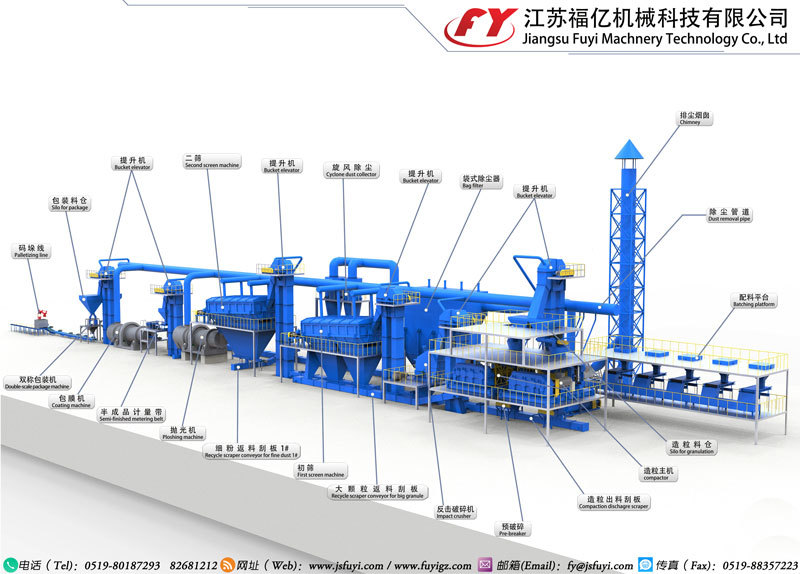
Compact Plant Design
Composition of fertilizers
Fertilizer formulations can be customized to the needs of the specific crop and /or soil to ensure optimal growth. This means that the formulation can be realized within every single grain. Each grain contains the same formulation, irrespective of its size.
Applicable Nutrients
Primary nutrients:
● Nitrogen
● Phosphorus
● Potassium
Secondary nutrients:
● Sulfur
● Calcium
● Magnesium
Micro-nutrients:
● Iron
● Manganese
● Zinc
● Boron
● Copper
● Molybdenum
● Chlorine
| Raw material | Nutrient content | Formulation examples | ||||||||||
| N(%) | P(%) | K(%) | 15-15-15(%) | 20-20- 20(%) | 16-16- 16(%) | 16-20- 0(%) | 18-20- 0(%) | |||||
| UR | 46 | - | - | 12 | 15 | 27 | 21 | 25 | 25 | 21 | 21 | 21 |
| AS | 21 | - | - | 19 | 26 | 14 | - | - | - | 13 | 13 | 13 |
| DAP | 18 | 46 | - | 34 | 17 | - | 34 | 42 | 42 | 17 | 17 | 17 |
| TSP | - | 46 | - | - | 17 | 34 | - | - | - | - | - | - |
| RP | - | 31 | - | - | - | - | - | - | - | 24 | 24 | 24 |
| MOP | - | - | 60 | 25 | 25 | 25 | 25 | 33 | 33 | 25 | 25 | 25 |
| Filler | - | - | - | 10 | - | - | 20 | - | - | - | - | - |
| Total: | 100 | 100 | 100 | 100 | 100 | 100 | 100 | 100 | 100 | |||
Keywords: DH series dry type roller press compactor
Recommended Products
 fy@fuyigz.com
fy@fuyigz.com
 0086-519-80181222
0086-519-80181222






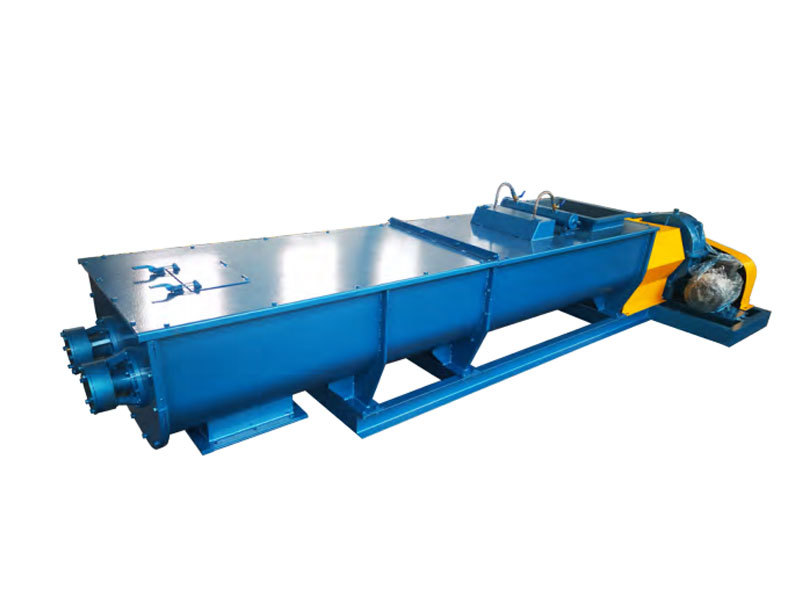
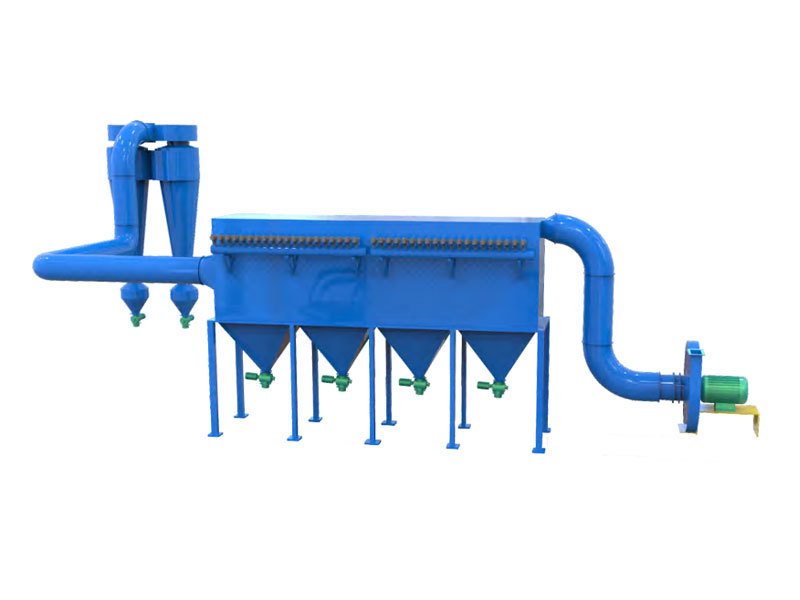
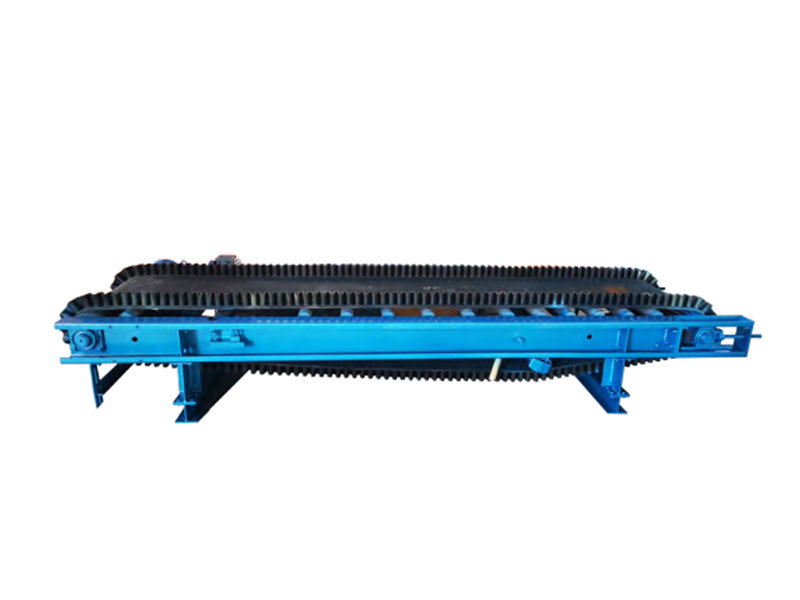
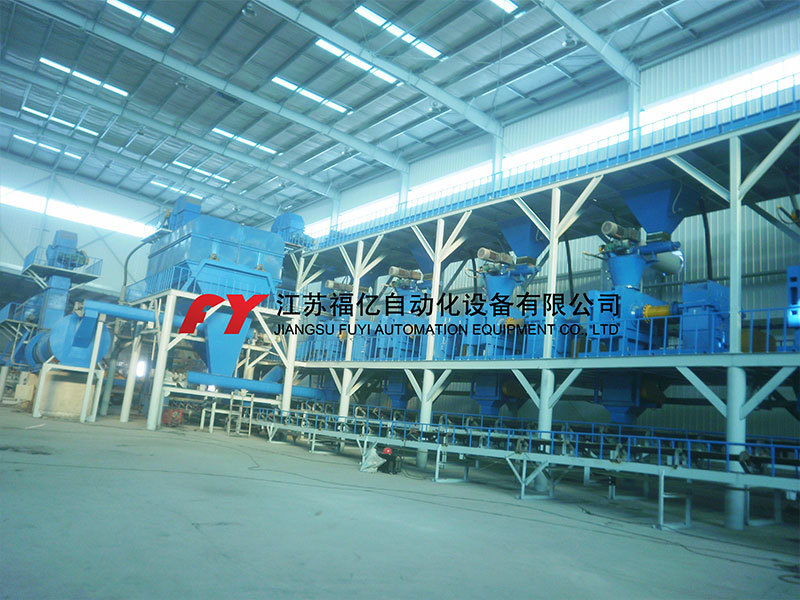















 fy@fuyigz.com
fy@fuyigz.com
 +61 426861120
+61 426861120
 Message
Message
